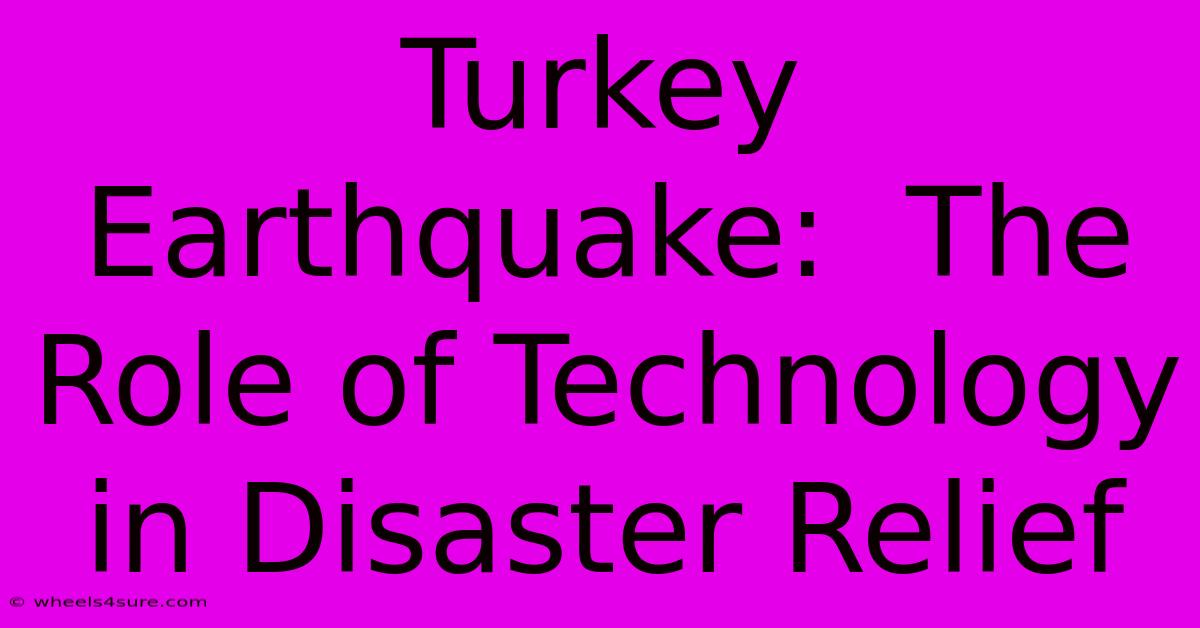Turkey Earthquake: The Role Of Technology In Disaster Relief

Table of Contents
Turkey Earthquake: The Role of Technology in Disaster Relief
The devastating earthquakes that struck Turkey and Syria in February 2023 highlighted both the immense human cost of such disasters and the increasingly crucial role of technology in disaster relief efforts. The scale of destruction was unprecedented, leaving millions displaced and in urgent need of assistance. In the face of such devastation, technology proved to be a vital tool, accelerating rescue operations, improving communication, and coordinating the delivery of aid.
Accelerated Rescue Operations: Technology's Crucial Role
The immediate aftermath of the earthquake saw a race against time to locate and rescue survivors trapped under rubble. Technology played a significant part in this frantic effort:
- Search and Rescue Robots: Remotely operated robots equipped with cameras and sensors were deployed to navigate unstable structures, identifying survivors and assessing the safety of potential rescue routes. These robots minimized risks to human rescuers in hazardous environments.
- Thermal Imaging Drones: Drones equipped with thermal imaging cameras proved invaluable in scanning large areas of debris quickly, identifying potential heat signatures indicating the presence of survivors. This expedited the search process considerably.
- Satellite Imagery: Satellite imagery provided crucial information about the extent of the damage, helping rescue teams prioritize areas most in need of immediate attention. High-resolution images allowed for precise assessment of building collapses and the identification of potential access points.
- Ground Penetrating Radar (GPR): This technology helped locate voids and potential survival spaces beneath the rubble, guiding rescue efforts more accurately.
Beyond the Immediate Rescue: The Long Road to Recovery
While rescue operations are critical in the immediate aftermath, the long-term recovery process also heavily relies on technology:
- Communication Networks: Restoring communication networks was crucial for coordinating relief efforts and connecting survivors with family and friends. Satellite phones and temporary communication infrastructure played a vital role in bridging the communication gap in affected areas.
- Logistics and Supply Chain Management: Technology-driven logistics platforms helped track the flow of aid, ensuring its efficient distribution to those who needed it most. This included mapping distribution centers, tracking delivery vehicles, and managing inventory.
- Early Warning Systems: The devastating impact of the earthquakes underscores the need for improved early warning systems. Investing in advanced seismic monitoring technology and developing effective communication channels for disseminating warnings is crucial for mitigating future risks.
- Building Assessments: Technology is being used to assess the structural integrity of buildings, identifying those safe for reoccupation and those requiring demolition or significant repair. This helps guide resettlement and rebuilding efforts.
- Digital Mapping and 3D Modeling: Creating detailed digital maps of affected areas assists in planning reconstruction efforts, identifying areas for temporary housing, and facilitating the distribution of resources. 3D modeling helps visualize the scale of damage and guide the reconstruction process.
Challenges and Limitations
Despite its significant contributions, the use of technology in disaster relief also faces challenges:
- Infrastructure limitations: The destruction of infrastructure, including power grids and communication networks, hampered the deployment and effectiveness of technological solutions.
- Access and equity: Not all affected areas had equal access to technological resources, creating disparities in the delivery of aid and support.
- Data security and privacy: The collection and use of personal data in disaster relief efforts raise important ethical considerations related to privacy and data security.
- Interoperability: Ensuring that different technological systems can seamlessly communicate and share information is crucial for effective coordination.
Looking Ahead: Technological Innovation for Future Disaster Relief
The Turkey earthquake underscored the need for ongoing investment in technological solutions for disaster relief. This includes further development of advanced sensors, robotics, communication technologies, and data analytics tools. Equally important is the development of strategies to ensure equitable access to these technologies and address the associated ethical challenges. By investing in these areas, we can significantly improve our ability to respond to future disasters and minimize their impact on vulnerable populations. The future of disaster relief relies heavily on the continued innovation and effective implementation of technology.

Thank you for visiting our website wich cover about Turkey Earthquake: The Role Of Technology In Disaster Relief. We hope the information provided has been useful to you. Feel free to contact us if you have any questions or need further assistance. See you next time and dont miss to bookmark.
Featured Posts
-
Hardik Pandyas Net Worth Growth Over The Years
Apr 04, 2025
-
Shyamalans Daughter Beyond The Sixth Sense
Apr 04, 2025
-
Ryan Reynolds Daughter Making A Difference In The World
Apr 04, 2025
-
The Real Story Behind Pamela Bachs Net Worth
Apr 04, 2025
-
Garggi Ananthans Age A Guide To Healthy Living
Apr 04, 2025
